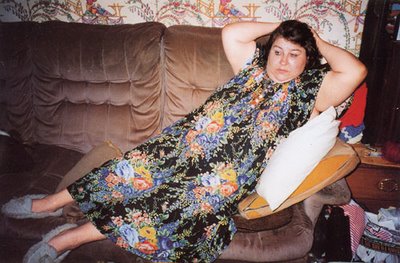
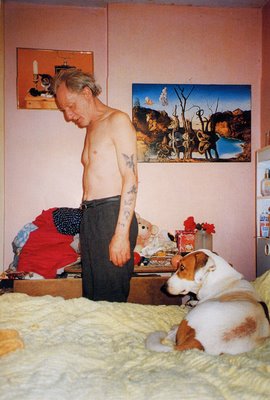
The Billingham family life unfolds before the lens, running the gamut of emotions from abject dejection to flurries of tenderness. There are idle moments, such as when a jigsaw puzzle is contentedly pieced together, or lying back on the sofa while the TV is on. Tiny kittens are lovingly fed milk through a little dropper, the obvious joy shining through in Liz's expression. There are minor accidents, such as trips and falls, or spillages: peas and carrots scatter across the kitchen floor before the half-bemused, half-opportunist gaze of the family dog. There is also confrontation, from glowering dagger-looks to blazing rows, with explosive situations where fists are threatened or the cat finds itself flung across the room. There is the muffled peace of a drunken haze, and unashamedly sweet moments of tender, familiar affection.
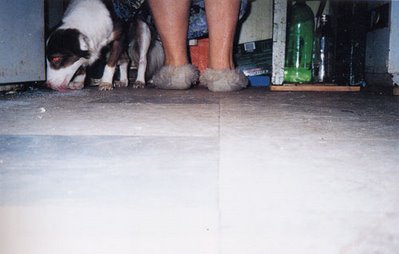
n 1996, a book of these family photographs, Ray's a Laugh, was published. Ray is the focus throughout the book. An alcoholic man who needs as much attention as a baby, his presence is constant, even when he is not in the frame. Ray drains the color out of the flat, seeming to live in a fog - gray jumpers, nicotine hair, brown liquid - oblivious of his surroundings. His wife Liz, however, injects color back into the home with her vibrant dresses and collections of porcelain knick-knacks. Liz is (obviously) the mother figure, mothering everyone from Ray to the pets.
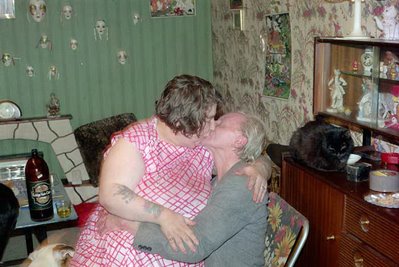

Upon publication, Ray's a Laugh - and the numerous European gallery exhibitions that sprang from it - caused a sensation. The subject matter and frank style of the works ensured an intrigued audience, but what really generated the buzz was the ambiguity of the images; the pictures left viewers to deal with their own reactions to the scenes, without the blatant lecturing normally received from images in the media. Generally in mass-media images, happy families are seen in spotlessly clean, well-ordered households. Not here. Equally, images of families living on the breadline in council estates usually present those people as demoralized victims living in a passive, defeated state of misery. Again, not here. Billingham's family images reveal the shallowness of most popular representations of the family, while emphasizing the complexity of family issues and social life, not to mention the difficult relation between the viewer and the viewed.
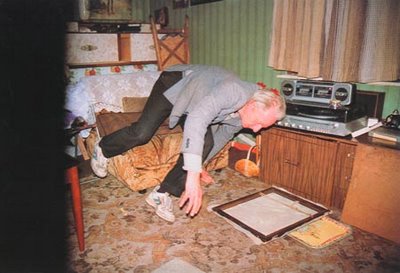
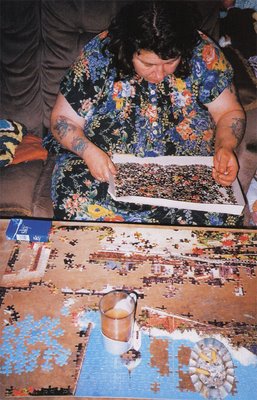

richard billingham :
'my father raymond is a chronic alcoholic.
he doesn't like going outside, my mother elizabeth hardly drinks,
but she does smoke a lot.
she likes pets and things that are decorative.
they married in 1970 and I was born soon after.
my younger brother jason was taken into care when he was 11,
but now he is back with ray and liz again.
recently he became a father.
'dad was some kind of mechanic, but he's always been an
alcoholic. it has just got worse over the years.
he gets drunk on cheap cider at the off license.
he drinks a lot at nights now and gets up late.
originally, our family lived in a terraced house,
but they blew all the redundancy money and, in desperation,
sold the house. then we moved to the council tower block,
where ray just sits in and drinks.
that's the thing about my dad, there's no subject he's interested
in, except drink.'
'it's not my intention to shock, to offend, sensationalise,
be political or whatever, only to make work that is as spiritually
meaningful as I can make it -
in all these photographs I never bothered with things like
the negatives. some of them got marked and scratched.
I just used the cheapest film and took them to be processed
at the cheapest place. I was just trying to make order out of chaos.'
Questions:
- Other than the obvious differences of the social class of the families depicted, how are Billingham's photographs different from Tina Barney's (see earlier post)?
- When Billingham writes "it's not my intention to shock, to offend, sensationalize," do you believe him?
- Quoting from the Cotton book- "The use of seemingly unskilled photography is an intentional device that signals the intimacy of the realtionship between the photographer and his or her subject." How can you relate this quote to Billingham's images?

14 comments:
These photographs certainly do not have the best overall quality. With out-of-date film Billingham have used, there are many scratches and dirt presented in the picture. Due to such fact, his photographs become very unique than other professional photographers. This makes his work so interesting to look at.
The choice of the subject is also very unique. Rather than to show us a perfect life style in his pictures, Billingham will capture the imperfect moment of our life such as when we are falling or get scared. This is almost like he is making a documentary of our plain daily life. Instead of dramatize or stylize his subject and present a perfect state, he simply report to viewer many chaos that happen to us all the time.
In addition to his choice of subject, Billingham also adds dirt and grain to his final work. This has made the photograph more original and closer to reality. As we all know, none of us have perfect happiness all the time, as we become sad, mad, angry and so forth. Therefore, his work really helped viewer to achieve their true feeling about their daily life.
I absolutely love these photos. The one of Ray throwing the cat is hysterical. I love it because it is crazy and insane and something that I think we only wish we could do sometimes when we're frustrated. Okay, maybe not. :)
I think a big difference between Billingham's photos and Tina Barney's is the lighting. Tina's photos seem much brighter and happier to me than Richard's. It makes a difference in that Tina's are staged too, and I can just tell they are. They are too right to be family snapshots trying to capture a moment, f-stop and shutter speed by darned. A lot of the subjects are looking straight at the camera in a lot of her photos which seems kind of off to me. Snapshots are a lot about capturing events and not a lot of them have the people in them looking right at the camera. I mean, look at Richard's photos. Ray and Liz are not looking at the camera in a single one. Also, Richard's photographs show real people having real interactions and emotions. Even when Ray or Liz are by themself in the photograph they are doing something whether it is falling out of a chair or doing a puzzle. The people in Tina's photographs just stand there and seem motionless and boring. For example in "Barney_MotherandSon460.jpg" I am bored out of my mind with what is going on. It doesn't seem like there is any interaction going on. However with the last Richard Billingham photograph where Ray and Liz are conversing, I want to know what they're talking about. I wonder if Liz is griping at Ray for not getting off his bum and doing something productive.
Moving on, Richard's photographs are fantastic because they give us a chance to see how his family lives. I think I enjoy it so much because a lot of these photographs bring back memories of experiences that I have had with my own family, or his parents remind me of members of my own family. There are not any alcoholics in my family, but Ray seems like an interesting person to be around. I bet that he can tell some good stories. I don't find these photographs offensive or shocking either. They are just showing us how this man's family lives and nothing more. I appreciate too how he uses the cheap film and shop down on the corner to get the film developed. This is something your grandma might have done to take pictures at your fifth birthday party you know? Buy a little disposable camera and get it processed. I am very fascinated by how people behave and like to people watch all the time. These photos by Richard give me a chance to do that, but I am able to study that one moment for longer than I could watching it happen in real life. It is just interesting to me how people act differently when they're around family and familiar ones. We seem to lose all our inhibitions and just be ourselves and Richard captures that in his photographs.
Buying cheap film and cheap developing shows Richard's closer relationship with the subject because you don't get that feeling of a need to depend on expensive equipment or development to capture what is everday to him, but is still important and loved. These photographs were never meant to be sold for profit because they were originally intended to be used for artistic inspiration, but they end up becoming something more. I have experienced the same when photographing a subject that I care about like my brother when working on a school assignment, but end up with images that mean something to me, but can also be of entertainment or interest to others.
These make me want to go out and buy a little cheap camera or film, and just snap photos of my family and see what comes out of it. They are highly inspirational images. I do wish I could say more, but I think I've blathered long enough.
Billingham says he was just trying to make order out of chaos. I find that quite amusing. Isnt that what we are all kind of trying to do? Maybe, maybe not. It is fitting for me at least. His work embodies real life. To me his photographs are so telling of his environment, his personal story. It is like looking at someone's family photo book, and as you flip through the pages, peices of their life and past get revealed to you, and when you are done you feel like you have some kind of connection or a better understanding of them. You are connected in that way that as a human you can relate to an experience or memory "kind of like that picture". As the Cotton book relates to the seemingly unskilled photography and its intentional use that signals the intamacy of the photographer and subject, I think its true here. You do get the feeling, he is there, even when he isnt in the frame. You sense Billingham's relationship with this environment and with these people as his family, not as "subjects" for a photo shoot. If you didnt get that from these works, I dont think that they would be as powerful or as engaging.
Billingham's photographs are different from Tina Barney's. For example Billingham's seems he used more flash to his subjects. The way I can tell because the corners edges are darker and the middle of the picture has a glowing circulation that makes the edges darker. Tina Barney's does not have darker edges. So there was no flash on most of the pictures. Yes I do believe him when Billingham wrote it's not my to shock, to offend, sensationalize. He is just trying to share how some parents go thru there life or how his parents are going thru there life. (treasuring the memories(we are not getting any younger)) The way I can relate the quote from question three to Billingam's is that I think is true. I agree what Brandon Wright said,I also get the feeling he is there, even if he is not in the picture. When I see the all the pictures. I don't see the parents posing for the picture take. They are going thru there usual life even if they are being photograph. This makes it very unique and true. In my opinion these photos came out great. You don't need to go to expensive photo place to get your film develop. Pictures are meant to retain the past memories.
To my prespective what is different between Billingham and Tina Barney is the sense of familiarity and warmed that the pictures convey. Billingham' pictures give a sense of affection if not love where as Barney's are more dry as if everybody in the family were strangers brought together to pose for such pictures. Not only that put I find that Billingham pictures have more color, more brightness I find them more appealing than Barneys. When Billingham said that he did not mean to shock or offend etc... I do believe him. The environment and emotions that are portrait in his photographs are what families are; the is no order no right nor wrong just family. There is no need to use the best film available to produce something amazing. Billingham, even though used the cheapest of the cheap to develop his film, like someone already mentioned, his pictures are amazing and they give you the freedom to speculate what was going on, what was he thinking while taking the pic. Overall I really enjoy his work, it was entertaining.
Oralia Gonzalez
Clearly, Tina Barney’s intimate photos seem to be more of the popular representation of the family. It seems as though the images are more staged, in comparison with the randomness and chaotic sense found in Billingham’s photos. And of course, there is a clear difference in the image quality. I like Barney’s photos, but there is something that attracts me to Billingham’s images. I think of all things it is the rawness found in them, as though we catch these real moments that are occurring in this unstable household. It encourages a sort of ambiguous feeling, not knowing how to react to the photos, which encourages me to just look at them even longer than before.
1. Other than the obvious differences of the social class of the families depicted, how are Billingham's photographs different from Tina Barney's (see earlier post)?
Everyone in the photos seemed to be very serious. No one was ever smiling and the activities they did didnt seem to involve much intimacy. Families were together, but thats about the extent of the closeness and love that they will show. In Richard Billingham's pictures, they didnt have the most luxurious possessions or lifestyle, but it seemed simple and happy and was filled with much more love.
# When Billingham writes "it's not my intention to shock, to offend, sensationalize," do you believe him?
I do. I think these photos were absolutely wonderful and if he said he was trying to shock or offend someone, I'd say I cant believe him.
# Quoting from the Cotton book- "The use of seemingly unskilled photography is an intentional device that signals the intimacy of the realtionship between the photographer and his or her subject." How can you relate this quote to Billingham's images?
I can. The 'seemingly unskilled photography' makes it seem like a real home photograph. It makes the subjects seem like family, rather than just another person being caught on film.
these photos are different other than the social class because these photos are not staged at all and they really are family pictues that they seem to be, unlike Tina Barney's whose images are staged and she used actors not even a real family.
the quote from the Cotton book relates to these photos because he was unskilled, he only took the pictues as references for paintings to start out with adn didn't care about the kind of film or if the prints where good or not and they are intamate images between the photographer and his subjects.
i do not like these images because they are disturbing so i do not believe him when he says it was not his intention, because he could have chosen other images or photographed other things in his home that would not have been as disturbing as these.
In the end these are just family photos. I can't really see how these got published as art. But then again anything seems to be art these days. Most of what made these pictures stand out when compared with other work is the result of limited resources not really intention. So I don't think the arist deserves that much credit.
They differ from Barney's in quality - at least that's what's most obvious to me. Because of this, they feel a lot more personal. I feel like I'm being shown family vacation photos - really, really, awkward family photos.
Also, they make me a little uncomfortable. It might be because of the tight spaces the models are in. I feel as if I'm being put in them as well, so it feels a bit claustrophobic. Barney's images don't have an effect like that on me.
I'm not quite sure if he really isn't trying to shock or offend people. He might not be, but I feel a little disturbed. He may be doing it unintentionally.
In my opinion Billingham's photos seem more intimate than Barney's. Yes, Barney's pictures are in an intimate setting, the home but, Billingham's photos seem to portray more intimate moments. They don't seem like moments that any neighbor could just walk in and witness; it makes the images that more real because they show the ups and downs of family life.
When Billingham writes "it's not my intention to shock, to offend, sensationalize," I do believe him. He's is just showing his reality and if that shocks or offends us that is simply because it is not our reality. I like images that seem real and his images really show the truth to me.
The Cotton book quote can be related to Billingham's images because of the fact that he did use poor quality film and processing. It makes the photos more realistic because you can believe that a member of the family could have just taken thus pictures to document their life. But had the photos looked more professional I don’t think the images would be as real because I would just think that it was all staged; b/c when you think of a professional coming in to take pictures you think of planning and staging.
These photos seem more real than the last. They are what people have in shoeboxes in the closet. Instead of being an issue of aesthetics, you get scenes that most people can relate to and that portray real life.
I don't think he means to shock, though the photos may in the sense of it being unorthodox for 'proper' photography on setting and style of prints.
I think Tina Barny's work showmore family crisis or family material more than Billingham. First of all, Tina's work staged really well and shows more of a feeling. I can't help but not be able to connect with Billingham photos because to me I feel like there is tragic in their home. After reading Billingham story, I felt out of place. I was disappointed more of his background with his dad than with the pictures. I could not relate at all to the pictures. Its kind of sad to see that he would take pictures of how is home was. I could not have done that. If hes not trying to shock people then why am I kind of shocked and unhappy with this work?
I enjoy these pictures in the same way that I enjoy Shafran's photographs. These pictures take what could be viewed as everyday life for the average man and turns it into something to be admired and saved. By doing so I think he alters the way that we look at our daily lives. We take these images to heart and begin to see them in our own lives, and in doing so, appreciate the beauty of the world we live in.
-Zach Phillips
Post a Comment